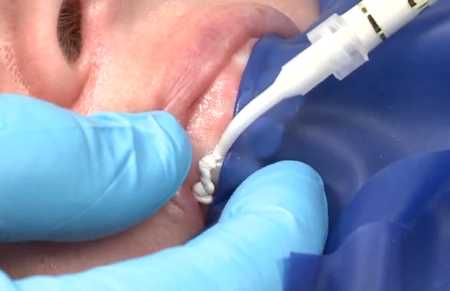Fluorosis is a disease that occurs primarily in areas with excess fluoride in drinking water. The disease usually affects the tooth enamel, less often the skeletal bones, caused by prolonged intake of fluoride and its compounds, which leads to the formation of pigmented spots of different size, shape and color on the enamel surface. Fluorosis usually affects symmetrical teeth, such as the central incisors.
Children between the ages of 4 and 6, who have lived in a certain area since birth, are the most susceptible to the disease. In adults, fluorosis develops less frequently. There is also reason to talk about occupational fluorosis.
It can occur in people working in industrial premises, in the air of which the fluoride content exceeds the sanitary standards.
Causes of Dental Fluorosis
The main cause of fluorosis is a large content of fluoride in drinking water. The optimal concentration of fluoride in water is 1 mg/l, above this value develops fluorosis.
In children, even a slight increase in fluoride content leads to a sharp increase in the disease. For adults, the critical level of fluoride in the water is 6 mg/l. At this concentration pathological changes can develop in the already formed bone tissues and tooth enamel. However in some cases, even relatively low levels of fluoride in drinking water can lead to fluorosis in adults, which is due to the individual characteristics of the body.
Also, the disease may be related to the amount of water you drink. It is known that, for example, in areas with hot and temperate climates, with the same concentration of fluoride in the water of the inhabitants of more southern latitudes fluorosis occurs more often.
Fluorosis Symptoms and Diagnosis
Fluorosis is manifested by damage to the enamel of the teeth. Depending on the severity of the lesion, the surface of the teeth may show white or brown stains, erosions, and traces of enamel damage. In severe cases, the disease affects the bones of the skeleton, and there may also be disorders of the autonomic nervous system, liver, general weakness and fatigue.
Fluorosis may be diagnosed by a dentist, pediatrician or internist, depending on the clinical manifestations of the disease. X-rays may be necessary for diagnosis if there are lesions of the skeletal bones.
Grades of Dental Fluorosis
There are three degrees of dental fluorosis – mild, moderate and severe.
The mild degree of the disease is characterized by minimal damage to the enamel in the form of a few spots or strips of chalky color. The pigmented areas occupy no more than a third of the tooth surface. They are located on the vestibular surface more often in the upper incisors than in the lower incisors.
When drying, the chalky spots become clearly visible and may merge into larger pigmented areas. Enamel is smooth, shiny.
In the medium degree, there is usually a superficial affection of enamel with its attenuation, and the enamel acquires a matte shade – from yellow to dark brown. Teeth can be erased up to the pigmented dentin, there are areas with broken enamel integrity, the erosion of enamel and dentin can be pronounced. The form of erosions is varied – from colorless to brown.
In severe forms of fluorosis, there is disruption of the tooth crown due to the erosion of enamel with dentin and erosions. The tooth becomes extremely brittle, and large sections of the crown may break off. The pulp is usually not exposed due to the deposition of large amounts of replacement dentin.
Treatment of Fluorosis
There is no specific treatment for this disease. The efforts of doctors are mainly aimed at the elimination of cosmetic defects of the teeth and the prevention of further development of fluorosis.
The therapy of fluorosis largely depends on the stage of the pathological process. For example, in the initial stage of fluorosis, which manifests itself only as a change of color of the enamel, a positive effect is given by bleaching procedures with subsequent remineralizing therapy. During treatment, it is recommended to take oral calcium preparations. The restoration of enamel is observed within 6-8 months. The course of treatment with the appearance of new pigmented spots must be repeated. It is also important to follow the rules of personal hygiene, to use pastes with remineralizing effect.
With moderate and severe fluorosis, methods are widely used to restore the shape and color of the tooth – dental aesthetic restoration. Composite materials, ceramic veneers or crowns are used for this purpose.
Prevention
The optimal content of fluoride in drinking water is 1 mg/l – with this concentration, on the one hand, fluorosis is quite rare, on the other hand – provides a pronounced anti-carious effect. In this regard, it is important to be aware of the fluoride content in the water we and our children drink. If the optimal concentration of fluoride is not maintained, it makes sense to stop using tap water as drinking water and replace it with bottled water. Other possible preventive measures in this situation are eating foods with reduced fluoride content and avoiding fluoride-containing toothpastes.
Prevention of occupational fluorosis should be aimed at eliminating employee contact with fluoride compounds. Here we can mention automation of production processes, sealing of equipment, mandatory use of personal protective equipment, regular preventive examinations, etc.
In the prevention of childhood fluorosis of great importance is played by breastfeeding, taking children out of the focal area in the summer, control the composition of drinking water, in particular, the annual replacement of water sources for 3-4 months in the first 8-10 years of life, reducing to a minimum the use of additional hygiene products with fluoride.






